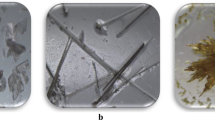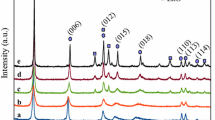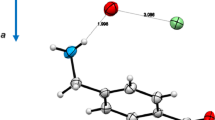Abstract
The structure of freshly prepared Al(OPh)3, its decomposition product, the hydrolyzed products and their structural evolution were investigated employing 27Al MAS NMR spectroscopy, PXRD, TGA/DTA/DSC/FTIR techniques. In the 27Al MAS NMR spectrum of the aluminium phenoxide, three signals with the chemical shift at 3.78, 21 and 45 ppm were observed. The chemical shift at 3.78 and 45 ppm revealed the presence of four and sixfold coordinated aluminum. The signal at 21 ppm corresponded to fivefold coordinated aluminium. When the aluminium phenoxide was directly decomposed in air at 600 °C, it resulted in amorphous product as evidenced from the PXRD pattern. The observed signals with chemical shifts at 10.1, 42, 73.6 ppm in the 27Al MAS NMR spectrum indicated the presence of 6, 5 and 4 coordination for the aluminium atoms suggesting disordered transitional γ-alumina to be the product. The hydrolysis studies of Al(OPh)3 with excess of water at 70 °C yielded bohemite (γ-AlOOH). The alumina obtained after dehydration at 600 °C was X-ray amorphous. The dehydrated product at 600 °C showed the presence of four and six coordinated aluminium atoms in the 27Al MAS NMR spectrum confirming it to be ordered γ-Al2O3. Crystalline γ-Al2O3 was obtained on further heating at 800 °C.











Similar content being viewed by others
References
Mehrotra RC, Rai AK (1991) Polyhedron 10:1967–1994
Kriz O, Casensky B, Lycka A, Fusek J, Hermanek S (1984) J Magn Reson 60:375–381
Malhotra KC, Kaur AJ, Kalra JMK (1985) J Indian Chem Soc 62:494–497
Meese-Marktscheffel JA, Cramer RE, Gilje JW (1994) Polyhedron 13:1045–1050
Malhotra KC, Martin RL (1982) J Organomet Chem 239:159–187
Sovar MM, Samelor D, Gleizes AN, Vahlas C (2007) Surf Coating Tech 201:9159–9162
Ramesh S, Sominska E, Cina B, Chaim R, Gedanken A (2000) J Am Ceram Soc 83:89–94
Adschiri T, Kanazawa K, Arai K (1992) J Am Ceram Soc 75:2615–2618
Jhon CS, Alma NCM, Hays GR (1983) Appl Catal 6:341–346
Kureti S, Wieswieler W (2002) Appl Catal A: General 225:251–259
Ramanathan S, Roy SK, Bhat R, Upadhyaya DD, Biswas AR (1997) Ceram Inter 23:45–53
Slade RCT, Southern JC, Thompson IM (1991) J Mater Chem 1:875–879
Kwak JH, Hu JZ, Kim DH, Szanyi J, Peden CHF (2007) J Catal 251:189–194
Nakamoto K (1977) Infrared and raman spectra of inorganic and coordination compounds, 3rd edn. Wiley Interscience Publication, New York
Bradely DC (1972) Adv Inorg Radiochem 15:259–322
Kleinschmidt DC, Shiner VJ Jr, Whittaker D (1973) J Org Chem 38:3334–3337
Oliver JG, Worral IJ (1970) J Chem Soc A 845–848
Oliver JG, Worral IJ (1970) J Cem Soc A 1389–1391
Kunicki A, Koinska W, Boleslawski M, Pasynkiewicz S (1977) J Organomet Chem 141:283–288
O’Reilly DE (1960) J Chem Phys 32:1007–1012
Athar T, Bohra R, Mehrotra RC (1989) Ind J Chem 28A:492–495
Flory PJ (1949) J Chem Phys 12:223–240
Turova NYA, Kozunov VA, Yanovskii AI, Bokii NG, Struchkov YUT, Tarnopol’skii BL (1979) J Inorg Nucl Chem 41:5–11
Hill MR, Baston TJ, Hill AJ (2009) Chem Mater 19:2877–2883
O’Dell LA, Savin SLP, Chadwick AV, Smith ME (2007) Solid State Nucl Magn Reson 31:169–173
Park YK, Tadd EH, Zubris M, Tannenbaum R (2005) Mat Res Bull 40:1506–15122
Urretavizcaya G, Cavalieri AL, Porto Lopez JM, Sobrados I, Sanz J (1998) J Mater Synth Proces 6:1–7
Werner SK (1974) Differential thermal analysis. Application and Results in Mineralogy, Berlin
Boumaza A, Favaro L, Ledion J, Sattonnay G, Brubach JB, Berthet P, Huntz AM, Roy P, Tetot R (2009) J Solid State Chem 182:1171–1176
Raharjo P, Ishizaki C, Ishizaki K (2000) J Ceram Soc Japan 108:1–5
Dorsey GA Jr (1968) Anal Chem 40:971–972
Liu Q, Wang A, Wang X, Gao P, Wang X, Zhang T (2008) Microporous Mesoporous Mater 111:323–333
Acknowledgments
The authors would like to record their sincere thanks to Department of Science and Technology, Government of India and University of Delhi for the financial support to carryout this work. Also thanks are due to Professor A.K. Ganguli and Professor A. Ramanan of Indian Institute of Technology (IIT, Delhi) for the use of XRD facility and to Indian Institute of Science, Bangalore, India for recording the 27Al MAS NMR.
Author information
Authors and Affiliations
Corresponding author
Rights and permissions
About this article
Cite this article
Tomar, N., Nagarajan, R. Effect of phenyl group on the structure and formation of transitional alumina from Al (OPh)3 . J Sol-Gel Sci Technol 53, 293–299 (2010). https://doi.org/10.1007/s10971-009-2090-3
Received:
Accepted:
Published:
Issue Date:
DOI: https://doi.org/10.1007/s10971-009-2090-3




